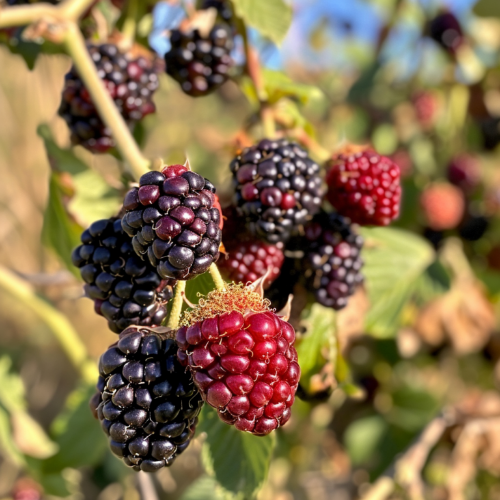Osage Blackberry
Osage Blackberry
Couldn't load pickup availability
| Mature Height | 4-5 ft |
|---|---|
| Mature Width | 3-6 ft |
| Plant Habit | Thornless, erect |
| Sunlight | Full |
| Spacing | 2-4 ft |
| Harvest Season | Mid-June to late July |
| Growing Zone | 6-8 |
Embarking on the journey of cultivating Osage Blackberry offers a rewarding path to sweet success for both novice and seasoned gardeners. Known for their exceptional flavor and large, juicy fruits, these versatile berries are a delightful addition to any garden. Understanding the specific needs of the Osage Blackberry—such as site selection, soil preparation, and care—is essential for achieving a bountiful harvest.
Planting guide
The foundation of a thriving Osage Blackberry garden begins with proper planting techniques.
How to plant Osage Blackberry bushes?
Begin by selecting a location that receives full sun for at least six to eight hours a day, as sunlight is crucial for fruit production and plant health. Prepare the soil by ensuring it is well-drained and fertile, with a pH between 5.5 and 6.5, and incorporate organic matter to enhance its structure. Once the soil and location are suitable, plant the blackberries in prepared holes, ensuring that the crown of each plant is just above the soil surface, and water them thoroughly.
When to plant Osage Blackberry bushes?
The ideal planting time for Osage Blackberry bushes is in early spring, as soon as the ground is workable. Planting during this period allows the plants to establish roots before the intense heat of summer. In milder climates, you may also plant in late fall, giving the bushes a head start before the spring growth period.
How far apart should you plant Osage Blackberry bushes?
Space Osage Blackberry bushes about 2 to 4 feet apart to ensure proper growth and air circulation, which reduces the risk of diseases. Maintain rows that are 10 to 12 feet apart to allow for easy access during maintenance and harvest. This spacing helps maximize sun exposure and promotes healthy fruit production.
About
Osage Blackberry bushes are prized for their sweet, juicy fruits and exceptional flavor, making them a standout choice for berry enthusiasts.
How tall does an Osage Blackberry bush grow?
Osage Blackberry bushes typically reach a height of 4 to 5 feet. Their upright growth habit makes them manageable and ideal for small to medium gardens. Regular pruning will help maintain their height and promote better air circulation.
How long does an Osage Blackberry bush live?
With proper care, Osage Blackberry bushes can thrive and produce fruit for many years, typically living up to 10 to 15 years. By maintaining healthy growing conditions and performing annual pruning, you can extend their longevity and productivity. Consistent attention to soil health and pest management also contributes to their lifespan.
How fast do Osage Blackberry bushes grow?
Osage Blackberry bushes exhibit moderate growth rates, with significant development occurring during the spring and early summer months. Newly planted bushes typically establish quickly, with noticeable growth by the first growing season. Vigorous growth can be encouraged through optimal care, nutrient-rich soil, and regular watering.
How to care for Osage Blackberry bushes?
Ensure your Osage Blackberry bushes receive at least six hours of sunlight daily and are planted in well-drained soil with a balanced pH. Regular watering is crucial, especially during dry spells, to keep the soil consistently moist but not waterlogged. Applying mulch around the base of the bushes aids in moisture retention, weed suppression, and temperature regulation, while also enriching the soil as it breaks down. Conduct regular inspections for pests and diseases to ensure prompt action and maintain plant health.
When to prune Osage Blackberry bushes?
Pruning Osage Blackberry bushes is best done in late fall or early spring, once the plants have become dormant and before new growth begins. This timing helps to encourage strong growth in the spring and improves air circulation. Dead or weak canes should be removed to boost the plant's vigor and fruit production.
How to prune Osage Blackberry bushes?
Begin by removing any dead, weak, or crossing canes to open up the plant's structure, allowing for better air circulation and sunlight penetration. Trim the remaining canes back to the desired height, typically around 3-4 feet, to encourage branching and fruiting. Always use clean, sharp pruning tools to make smooth cuts, reducing the risk of spreading diseases to healthy parts of the bush.
Share

